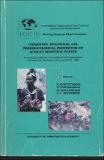| dc.contributor.author | Amusan, O.O.G. | |
| dc.contributor.author | Adesogan, E.K. | |
| dc.contributor.author | Makinde, J.M. | |
| dc.coverage.spatial | Africa. | en |
| dc.date.accessioned | 2016-04-26T11:50:56Z | |
| dc.date.available | 2016-04-26T11:50:56Z | |
| dc.date.issued | 1996-02-25 | |
| dc.identifier.citation | Amusan, O.O.G, Adesogan, E.K and Makinde, J.M. (1996) Antimalarial active principles of Spathodea Campanulata. In: Hostettmann, K., Chinyanganya, F., Maillard, M. and Wolfender, J.-L. (eds.) Chemistry, biological and pharmacological properties of African medicinal plants: proceedings of the first International IOCD-Symposium, Victoria Falls, Zimbabwe, February 25-28 1996. Harare: UZ Publications, pp. 309-315. | en |
| dc.identifier.isbn | 0-908307-59-4 | |
| dc.identifier.uri | https://opendocs.ids.ac.uk/opendocs/handle/20.500.12413/11445 | |
| dc.description | A symposium paper on medicinal plant species of Africa. | en |
| dc.description.abstract | Spathodea campanulata P. Beauvais (Bignoniaceae) is one of the important plants used in traditional medicine, whose chemical analysis has been recommended (Oliver-Bever 1960). This plant is used in traditional medicine for the management of malaria and the blood schizontocidal action of the alcoholic extract of its leaves against Plasmodium berghei berghei in mice has been described (Makinde et al. 1987). Extracts of the stem bark of the tree also demonstrated antimalarial activity against P. berghei berghei in mice both in early and established infections (Makinde et al. 1988).
Column chromatography was effective for the isolation of three fractions of the stem bark which demonstrated antimalarial properties (Makinde et al. 1990). Two of which, fractions B and C were obtained from the chloroform extract while one fraction (Z) was obtained from the hexane extract of the stem bark (Makinde et al. 1990). Phytochemical investigation has led to the characterization of the antimalarial active principles in the leaves and in the three fractions of the stem bark of Spathodea campanulata using spectroscopic methods and chemical transformations. The isolation of these antimalarial compounds from the stem bark of S. campanulata is noteworthy in the current search for new antimalarial drugs since these compounds have never been reported to have antimalarial action. | en |
| dc.description.sponsorship | International Organization for Chemical Sciences in Development (IOCSD) | en |
| dc.language.iso | en | en |
| dc.publisher | University of Zimbabwe (UZ) Publications | en |
| dc.rights.uri | http://creativecommons.org/licenses/by-nc-nd/3.0/ | en |
| dc.subject | Health | en |
| dc.subject | Science and Society | en |
| dc.title | Antimalarial active principles of Spathodea Campanulata | en |
| dc.type | Conference paper | en |
| dc.rights.holder | University of Zimbabwe (UZ) | en |


